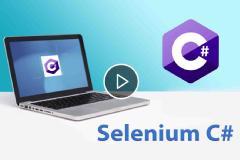Selenium WebDriver - Python
The "Selenium WebDriver Using Python" course is designed to provide participants with a comprehensive understanding of how to automate web applications using Selenium WebDriver with the Python programming language. This hands-on course will equip you with the skills needed to create robust and maintainable test automation scripts, effectively improve the testing process, and ensure the quality of web applications.
Course Highlights:
-
Duration: 6 weeks / 1.5 to 2 hours of per day (Flexible Timings)
Selenium WebDriver
Course Outline:
Module 1: Introduction to Selenium and Automation Testing
-
Importance of automation testing in modern software development
-
Overview of Selenium and its components
-
Setting up the development environment (Python, IDE)
Module 2: Getting Started with Selenium WebDriver and Python
-
Introduction to Selenium WebDriver
-
Installation and configuration of WebDriver and browser drivers
-
Creating a basic Python project for automation
Module 3: Locating Web Elements
-
Exploring different types of locators (ID, Name, XPath, CSS Selector)
-
Techniques for robust element identification
Module 4: Interacting with Web Elements
-
Performing actions such as clicking, typing, submitting forms
-
Handling dropdowns, radio buttons, checkboxes, and file uploads
-
Managing alerts, frames, and windows
Module 5: Synchronization and Waits
-
Understanding synchronization challenges in web automation
-
Implementing implicit and explicit waits
-
Handling AJAX calls and dynamic content loading
Module 6: Test Automation Frameworks with pytest
-
Introduction to pytest for test management and reporting
-
Organizing test suites and test cases
-
Parameterization and data-driven testing with pytest
Module 7: Page Object Model (POM) Design Pattern
-
Introduction to the Page Object Model design pattern
-
Creating a POM-based automation framework
-
Benefits of using POM for test maintainability
Module 8: Advanced Interactions and Actions
-
Using ActionChains for mouse and keyboard interactions
-
Handling drag-and-drop, context menus, and hover actions
-
Working with iframes and nested frames
Module 9: Data-Driven Testing
-
Parameterizing tests using pytest's parametrize decorator
-
Reading test data from external sources (Excel, CSV, etc.)
Module 10: Cross-Browser and Parallel Testing
-
Configuring and executing tests on different browsers
-
Running tests in parallel for efficient test execution
Module 11: Test Maintenance and Best Practices
-
Strategies for creating maintainable and reusable scripts
-
Debugging and troubleshooting common issues
-
Version control and collaboration in automation projects
Python Programming
Course Outline:
Module 1: Introduction to Python Programming
-
Overview of the Python programming language
-
Setting up the development environment (Python interpreter, IDE)
-
Writing and running the first Python program
Module 2: Basic Syntax and Structure
-
Understanding Python program structure
-
Writing comments and using identifiers
-
Declaring variables and data types
Module 3: Operators and Expressions
-
Exploring arithmetic and relational operators
-
Using operators in expressions
-
Operator precedence and associativity
Module 4: Control Flow
-
Conditional statements: if, elif, else
-
Looping: while, for loops
-
Break and continue statements
Module 5: Functions and Modules
-
Defining and calling functions
-
Function parameters and return values
-
Using built-in and user-defined functions
Module 6: Lists and Tuples
-
Introduction to lists and tuples
-
Accessing and manipulating list elements
-
List comprehensions
Module 7: Strings and String Manipulation
-
Working with strings: concatenation, slicing
-
String methods for manipulation and searching
-
String formatting
Module 8: Dictionaries and Sets
-
Understanding dictionaries and sets
-
Adding, accessing, and modifying dictionary items
-
Working with sets and set operations
Module 9: File Handling
-
Reading and writing files in Python
-
Using file objects and context managers
-
Processing text and data from files
Module 10: Exception Handling
-
Understanding exceptions and error handling
-
Using try-except blocks
-
Handling multiple exceptions
Module 11: Basic Object-Oriented Programming (OOP)
-
Introduction to object-oriented programming (OOP) concepts
-
Creating classes and objects
-
Using constructors and methods
Module 12: Modules and Packages
-
Importing and using modules in Python
-
Organizing code into packages and modules
-
Creating and using custom modules









